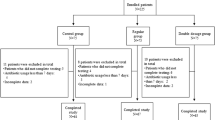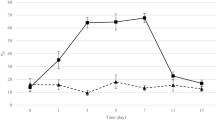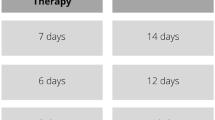Summary
The normal flora of the intestinal tract, mainly consisting of anaerobic bacteria, protects the host against colonization by pathogenic microorganisms. Antimicrobial treatment with ceftriaxone may influence the colonic microflora and as a consequence, the protective effect. Ten healthy volunteers received 1 g of ceftriaxone intramuscularly for five days. This resulted in a significant decrease (p<0.05) of the mean cultural counts (± SEM) of total anaerobes from 10.67 (0.11) (prior to treatment) to 9.02 (0.45) and 8.97 (0.46) at days 3 and 5, respectively (during treatment). After treatment (days 10 and 15–19), the cultural counts of anaerobes returned to 10.17 (0.16) and 10.44 (0.18), respectively. Bacterial enzymes may serve as an indicator of protective microflora. β- aspartylpeptidase and deoxycholate hydrolase activity was determined in faecal supernatants of the volunteers and compared with anaerobic culturing. Both enzymatic activities show a significant correlation with the total number of anaerobes present at day 3 of ceftriaxone treatment. At day 5 and 8 only β-aspartylpeptidase showed significant correlations with cultural counts of total anaerobes,Bacteroides spp. or bifidobacteria. At day 15 to 19 (ten to 14 days after treatment) β-aspartylpeptidase showed only a significant correlation with the number ofBacteroides spp. This indicates that changes in the indigenous bacterial flora during and shortly after treatment with ceftriaxone can be monitored by determination of β-aspartylpeptidase. Recovery of the intestinal flora is difficult to assess in this manner.
Zusammenfassung
Die normale Flora des Intestinaltraktes besteht vorweigend aus anaeroben Bakterien und schützt den Wirt gegen eine Kolonisation durch pathogene Mikroorganismen. Eine antimikrobielle Therapie mit Ceftriaxon kann die Mikroflora des Dickdarms beeinträchtigen und damit auch deren protektiven Effekt. Zehn gesunde Probanden erhielten fünf Tage lang 1 g Ceftriaxon intramuskulär appliziert. Dies führte zu einer signifikanten Abnahme der mittleren Koloniebildnerzahlen von 10,67 (SEM ± 0,11) vor Applikation auf 9,02 (± 0,45) nach drei und auf 8,97 (± 0,46) nach fünf Tagen (p<0,05). Nach zehn und 15 bis 19 Tagen im Anschluß an die Antibiotikagabe kehrten die Anaerobier-Koloniebildnerzahlen auf 10,17 (± 0,16) bzw. 10,44 (± 0,18) zurück. Bakterienenzyme können als Indikator für die protektive Mikroflora dienen. In Überständen von Stuhlproben der Probanden wurden β-Aspartylpeptidase und Desoxycholat-Hydrolase bestimmt und mit den Anaerobier-Kulturen verglichen. Zwischen den Aktivitäten beider Enzyme und der am Tag 3 gemessenen Anaerobier-Gesamtzahl fand sich eine signifikante Korrelation. Am Tag 5 und Tag 8 zeigte nur die β-Aspartylpeptidase eine signifikante Korrelation mit den Gesamt-Kolonie-bildnerzahlen der Anaerobier sowie mit den Zahlen vonBacteroides spp. oder Bifidobakterien. An den Tagen 15 bis 19 (zehn bis 14 Tage nach Antibiotikagabe) bestand nur zwischen der Zahl vonBacteroides spp. und β-Aspartylpeptidase eine signifikante Korrelation. Nach Behandlung mit Ceftriaxon lassen sich folglich Veränderungen der bakteriellen Flora kurzfristig durch Bestimmung der β-Aspartylpeptidase erfassen, weniger gut aber die Erholung der Darmflora.
Similar content being viewed by others
References
van der Waaij, D. Colonization resistance of the digestive tract; clinical consequences and implications. J. Antimicrob. Chemother. 10 (1982) 263–270.
van der Waaij, D., Aberson, J., Thijm, H. A., Welling, G. W. The screening of four aminoglycosides in the selective decontamination of the digestive tract in mice. Infection 10 (1982) 35–40.
van der Waaij, D. The ecology of the human intestine and its consequences for overgrowth by pathogens such asClostridium difficile. Ann. Rev. Microbiol. 43 (1989) 69–87.
Angehrn, P., Probst, P. J., Reiner, R., Then, R. L. Ro 13-9904, a long-acting broad-spectrum cephalosporin:in-vitro andin-vivo studies. Antimicrob. Agents Chemother. 18 (1980) 913–921.
Richards, D. M., Heel, R. C., Brogden, R. N., Speight, T. M., Avery, G. S. Ceftriaxone, a review of its antibacterial activity, pharmacological properties and therapeutic use. Drugs 27 (1984) 469–527.
Arvidsson, A., Alván, G., Angelin, B., Borgå, O., Nord, C. E. Ceftriaxone: renal and biliary excretion and effect on the colon microflora. J. Antimicrob. Chemother. 10 (1982) 207–215.
Bodey, G. P., Fainstein, V., Garcia, I., Rosenbaum, B., Wong, Y. Effect of broad-spectrum cephalosporins on the microbial flora of recipients. J. Infect. Dis. 148 (1983) 892–897.
Nilsson-Ehle, I., Nord, C. E., Ursing, B. Ceftriaxone: Pharmacokinetics and effect on the intestinal microflora in patients with acute bacterial infections. Scand. J. Infect. Dis. 17 (1985) 77–82.
Michéa-Hamzehpour, M., Auckenthaler, R., Kunz, J., Pechère, J.-C. Effect of a single dose of cefotaxime or ceftriaxone on human faecal flora. Drugs 35 (Suppl. 2) (1988) 6–11.
Léonard, F., Andremont, A., Leclerq, B., Labia, R., Tancrède, C. Use of β-lactamase-producing anaerobes to prevent ceftriaxone from degrading intestinal resistance to colonization. J. Infect. Dis. 160 (1989) 274–280.
Welling, G. W. Comparison of methods for the determination of β-aspartylglycine in faecal supernatants of leukemic patients treated with antimicrobial agents. J. Chromatogr. 232 (1982) 55–62.
Holdeman, L. V., Cato, E. P., Moore, W. E. C. (eds. Anaerobe laboratory manual, 4th ed. Virginia Polytechnic Institute and State University, Blacksburg, Va., USA, 1977.
Meijer-Severs, G. J., van Santen, E., Meijer, B. C. Short-chain fatty acids and organic acid concentrations in feces of healthy human volunteers and their correlation with anaerobe cultural counts during systemic ceftriaxone administration. Scand. J. Gastroenterol. 25 (1990) 698–704.
Wissenschaftliche Tabellen Geigy Teilband Statistik. 8th ed. (1980) Geigy, Basel, Switzerland.
Welling, G. W., Groen, G., Welling-Wester, S., de Vries-Hospers, H. G., van der Waaij, D. Enzymatic inactivation of aztreonam by faecal enzyme preparations from healthy volunteers. Infection 15 (1987) 188–191.
Welling, G. W., Stege, G. J. J., Meijer-Severs, G. J. β-aspartylpeptidase activity, a microflora associated characteristic (MAC); its presence in different strains of anaerobic bacteria. Microbial Ecology in Health and Disease 1 (1988) 45–49.
Owen, R. W. The metabolism of bile acids. In:Hill, M. J. (ed.): Microbial metabolism in the digestive tract. CRC Press, Inc., Boca Raton 1986, pp. 52–65.
Author information
Authors and Affiliations
Rights and permissions
About this article
Cite this article
Welling, G.W., Meijer-Severs, G.J., Helmus, G. et al. The effect of ceftriaxone on the anaerobic bacterial flora and the bacterial enzymatic activity in the intestinal tract. Infection 19, 313–316 (1991). https://doi.org/10.1007/BF01645354
Received:
Accepted:
Issue Date:
DOI: https://doi.org/10.1007/BF01645354




